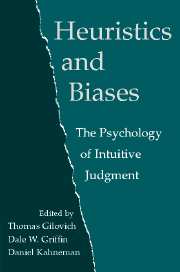Book contents
- Frontmatter
- Contents
- List of Contributors
- Preface
- Introduction – Heuristics and Biases: Then and Now
- PART ONE THEORETICAL AND EMPIRICAL EXTENSIONS
- PART TWO NEW THEORETICAL DIRECTIONS
- PART THREE REAL-WORLD APPLICATIONS
- 33 The Hot Hand in Basketball: On the Misperception of Random Sequences
- 34 Like Goes with Like: The Role of Representativeness in Erroneous and Pseudo-Scientific Beliefs
- 35 When Less Is More: Counterfactual Thinking and Satisfaction among Olympic Medalists
- 36 Understanding Misunderstanding: Social Psychological Perspectives
- 37 Assessing Uncertainty in Physical Constants
- 38 Do Analysts Overreact?
- 39 The Calibration of Expert Judgment: Heuristics and Biases Beyond the Laboratory
- 40 Clinical versus Actuarial Judgment
- 41 Heuristics and Biases in Application
- 42 Theory-Driven Reasoning about Plausible Pasts and Probable Futures in World Politics
- References
- Index
36 - Understanding Misunderstanding: Social Psychological Perspectives
from PART THREE - REAL-WORLD APPLICATIONS
Published online by Cambridge University Press: 05 June 2012
- Frontmatter
- Contents
- List of Contributors
- Preface
- Introduction – Heuristics and Biases: Then and Now
- PART ONE THEORETICAL AND EMPIRICAL EXTENSIONS
- PART TWO NEW THEORETICAL DIRECTIONS
- PART THREE REAL-WORLD APPLICATIONS
- 33 The Hot Hand in Basketball: On the Misperception of Random Sequences
- 34 Like Goes with Like: The Role of Representativeness in Erroneous and Pseudo-Scientific Beliefs
- 35 When Less Is More: Counterfactual Thinking and Satisfaction among Olympic Medalists
- 36 Understanding Misunderstanding: Social Psychological Perspectives
- 37 Assessing Uncertainty in Physical Constants
- 38 Do Analysts Overreact?
- 39 The Calibration of Expert Judgment: Heuristics and Biases Beyond the Laboratory
- 40 Clinical versus Actuarial Judgment
- 41 Heuristics and Biases in Application
- 42 Theory-Driven Reasoning about Plausible Pasts and Probable Futures in World Politics
- References
- Index
Summary
Researchers in many subdisciplines of psychology have made their reputations cleverly documenting the various cognitive, perceptual, and motivational biases that systematically distort human judgment and inference. In this chapter, we explore some of the interpersonal and intergroup consequences of such biases. In particular, we consider the role these biases can play in creating, exacerbating, and perpetuating conflict between individuals and between groups.
One way in which biases contribute to conflict is obvious. When different peopleare subject tothe influenceof differentbiases, they are boundto thinkand feel differently about issues. And people who disagree with each other – indeed, even people who are reasonably like minded but attach different priorities to the problems they feel should be addressed or the actions they feel should be taken – are apt to frustrate each other's efforts and ambitions. There is, however, a second way in which biases fuel enmity that is less direct, but not less important. People and groups who disagree about matters of mutual concern not only interact in conflictual ways; they also interpret, and frequently misinterpret, each other's words and deeds. The nature of such misattributions, and their consequences, occupies most of our attention in this chapter. First, however, we begin by simply noting some well-studied cognitive and motivational biases and illustrating how they might foster interpersonal and intergroup enmity.
- Type
- Chapter
- Information
- Heuristics and BiasesThe Psychology of Intuitive Judgment, pp. 636 - 665Publisher: Cambridge University PressPrint publication year: 2002
- 39
- Cited by

